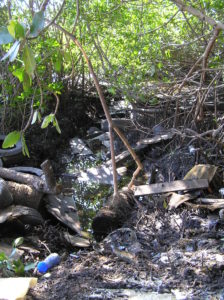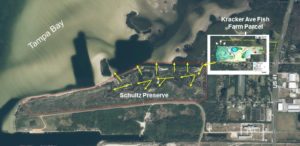Above: Proposed habitat enhancements at a former fish farm in Hillsborough County, the left shows an aerial view of the former fish farm property and the right is the proposed habitat improvement plans.
What do you do when you have reclaimed water nationally recognized for its quality in a county where low-salinity habitats have been highly impacted? Use it to replace the natural freshwater inflow that has been removed for drinking water.
Hillsborough County’s reclaimed water is in the top 2% of the nation for quality, said Bart Weiss, director of Hillsborough County’s reclaimed water division. It meets all standards for drinking water except for salt.
“It’s the first time I know of that utilities and scientists propose using reclaimed water to help fish and ecosystems,” said Weiss, “There are other places that discharge into grassy wetlands that may have a similar impact, but they haven’t focused on ecosystems as much as we have.”

The project site, located at the end of Kracker Avenue, was purchased with $128,000 from Hillsborough County’s Jan K. Platt Environmental Lands Acquisition and Protection Program. The Southwest Florida Water Management District’s Surface Water Improvement and Management (SWIM) program allocated $1.25 million to restore the site.
The 25-acre property, formerly the site of Bramco Tropical Fish, was abandoned in the 1970s. Since then, the hundreds of shallow ponds where tropical fish were grown have been overtaken by invasive species. Hillsborough County and SWIM, working with the Bonefish and Tarpon Trust, will restore the site to a mosaic of habitats from uplands to very low salinity areas to intertidal lagoons and islands to meet the specific needs of recreationally important fish including tarpon, redfish, sea trout and snook.
“The goal is to mimic natural processes by using water that’s currently being discharged near Port Redwing,” said Brandt Henningsen, SWIM’s chief advisor and environmental scientist. “It’s a valuable opportunity for us to offset the losses of natural tidal creeks in the area.”
After the water flows through the Kracker Avenue site, it will overflow into the adjacent Schultz Preserve (http://baysoundings.com/legacy-archives/wint05/preserve.html) where it will supplement stormwater that has been used to create a low-salinity habitat on what had been a dredged-and-filled peninsula. Near-shore, lush seagrass beds abut dredge holes that provide warmer waters during cold weather for temperature-sensitive fish like snook.
‘It will be a very dynamic system with pulses of fresh water — not constant flows,” adds Mary Barnwell, the county’s environmental land management coordinator. The site also will include the nation’s first butterfly garden planted specifically for monarchs, funded through a National Fish and Wildlife Foundation grant.
 The wide variety of habitats makes it an outstanding location to see where fish – specifically tarpon, in this case – thrive, notes JoEllen Wilson, manager of the Bonefish and Tarpon Trust’s juvenile tarpon habitat program. “There’s so little known about what works and what doesn’t,” she said. She’ll lead teams of volunteers as the restoration is completed to see how well juvenile tarpon grow in the new habitat, as well as the intertidal lagoons at Schultz Preserve which larger juveniles are expected to use.
The wide variety of habitats makes it an outstanding location to see where fish – specifically tarpon, in this case – thrive, notes JoEllen Wilson, manager of the Bonefish and Tarpon Trust’s juvenile tarpon habitat program. “There’s so little known about what works and what doesn’t,” she said. She’ll lead teams of volunteers as the restoration is completed to see how well juvenile tarpon grow in the new habitat, as well as the intertidal lagoons at Schultz Preserve which larger juveniles are expected to use.
Tarpon are considered an “umbrella species” because their lifecycle is so similar to other important fish, she adds. They spawn offshore in the summer and their larvae move into protected backwaters where high levels of detritus fuel the growth of small fish, crabs and shrimp while the shallow, low-salinity water protects them from larger fish. (Learn more about building habitat for juvenile snook at Robinson Preserve http://baysoundings.com/robinson-preserve-transformed-to-host-juvenile-snook/)
“Studies on the east coast have shown that juvenile tarpon are opportunistic eaters – they’ll eat pretty much anything they can catch,” she said.
The Kracker property also is protected from the open bay by a shallow weir that connects with Schultz Preserve during periods of heavy rains and very high tides so the larvae will have access and a way to leave once they’re large enough to swim out into the intertidal lagoons at Schultz, Wilson adds.
“We’re evolving very quickly into an organization focused on adaptive science,” she said. “Anglers have been reporting on juveniles – for tarpon, that’s fish under 12 inches – and the kind of habitat they’re seeing them in.”
The research at Kracker and Schultz takes that less-formal study a step forward by looking at the same spots over time in situations specifically created to boost fish populations, she adds. “We’ve destroyed so much of the coastal habitats these fish need to survive that we really need to focus on quality. We need to fix what’s left because we’ll never have that quantity again.”
Check out how the Kracker Ave site (formerly a fish farm) has transformed over the past 70 years, just click on the double arrows in upper left corner, click the boxes to turn aerial image options on and off to see how drastically the site has changed.
